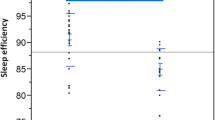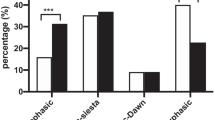Abstract
Background
The association between the hypothalamic–pituitary–adrenal (HPA) axis and sleep is well described. It is also known that HPA axis disturbances have an effect on sleep. In fact, patients affected by Cushing’s syndrome (CS) often complain about poor sleep quality. Our aim was to evaluate objective sleep quality and duration in patients with Cushing’s syndrome in active phase, using wrist actigraphy.
Patients and methods
In 12 patients with active CS without ongoing specific therapy (11 F, 1 M; age 40.0 ± 10.9 years; BMI 28.4 ± 6.7 kg/m2) and 12 healthy control subjects (HS) (11 F, 1 M; age 44.0 ± 11.0 years; BMI 23.9 ± 4.2 kg/m2) an actigraphic evaluation was performed on 3 consecutive days under free living conditions. Objective measurement of sleep duration and quality was estimated by an actiwatch, which is a wristwatch-like device used to detect motor activity.
Results
In CS patients, wrist actigraphy showed higher fragmented sleep (fragmentation index CS 16.2 ± 4.2, HS 13.0 ± 3.6; p = 0.034) and increased nocturnal motor activity (total activity score CS 8318 ± 4308, HS 4971 ± 2372; p = 0.020; mean activity score CS 8.7 ± 4.2, HS 5.4 ± 2.2; p = 0.030; mean score in active time CS 104.8 ± 39.2, HS 74.8 ± 23.1; p = 0.030). On the contrary, actual sleep time resulted similar in CS and HS. No correlation was found between sleep alterations and urinary free cortisol in patients.
Conclusions
The impaired actigraphic parameters described in our study suggest that hypercortisolism is associated with sleep alterations, which could contribute to the worsening of life quality and metabolic comorbidities associated with CS. These results have to be confirmed in a larger cohort of patients, using more accurate instruments for sleep assessment.
Similar content being viewed by others
References
Lindholm J, Juul S, Jorgensen JO et al (2001) Incidence and late prognosis of Cushing’s syndrome: a population-based study. J Clin Endocrinol Metab 86(1):117–123
Etxabe J, Vazquez JA (1994) Morbidity and mortality in Cushing’s disease: an epidemiological approach. Clin Endocrinol (Oxf) 40(4):479–484
Mancini T, Kola B, Mantero F, Boscaro M, Arnaldi G (2004) High cardiovascular risk in patients with Cushing’s syndrome according to 1999 WHO/ISH guidelines. Clin Endocrinol (Oxf) 61(6):768–777
Starkman MN (2013) Neuropsychiatric findings in Cushing syndrome and exogenous glucocorticoid administration. Endocrinol Metab Clin North Am 42(3):477–488
Krieger DT, Glick SM (1974) Sleep EEG stages and plasma growth hormone concentration in states of endogenous and exogenous hypercortisolemia or ACTH elevation. J Clin Endocrinol Metab 39(6):986–1000
Shipley JE, Schteingart DE, Tandon R, Starkman MN (1992) Sleep architecture and sleep apnea in patients with Cushing’s disease. Sleep 15(6):514–518
Ancoli-Israel S, Cole R, Alessi C, Chambers M, Moorcroft W, Pollak CP (2003) The role of actigraphy in the study of sleep and circadian rhythms. Sleep 26(3):342–392
Morgenthaler T, Alessi C, Friedman L et al (2007) Practice parameters for the use of actigraphy in the assessment of sleep and sleep disorders: an update for 2007. Sleep 30(4):519–529
Jean-Louis G, von Gizycki H, Zizi F, Spielman A, Hauri P, Taub H (1997) The actigraph data analysis software: I. A novel approach to scoring and interpreting sleep-wake activity. Percept Mot Skills 85(1):207–216
Beccuti G, Pannain S (2011) Sleep and obesity. Curr Opin Clin Nutr Metab Care 14(4):402–412
Pannain S, Beccuti G, Van Cauter E (2012) The connection between sleep loss, obesity, and type 2 diabetes. In: Shiromani P, Horvath T, Redline S, Van Cauter E (eds) Sleep loss and obesity: intersecting epidemics. Springer, New York, pp 133–168
Dong JY, Zhang YH, Qin LQ (2013) Obstructive sleep apnea and cardiovascular risk: meta-analysis of prospective cohort studies. Atherosclerosis 229(2):489–495
Nieman LK, Biller BM, Findling JW et al (2008) The diagnosis of Cushing’s syndrome: an endocrine society clinical practice guideline. J Clin Endocrinol Metab 93(5):1526–1540
Newell-Price J, Grossman AB (2007) Differential diagnosis of Cushing’s syndrome. Arq Bras Endocrinol Metabol 51(8):1199–1206
Steiger A (2002) Sleep and the hypothalamo-pituitary-adrenocortical system. Sleep Med Rev 6(2):125–138
Buckley TM, Schatzberg AF (2005) On the interactions of the hypothalamic-pituitary-adrenal (HPA) axis and sleep: normal HPA axis activity and circadian rhythm, exemplary sleep disorders. J Clin Endocrinol Metab 90(5):3106–3114
Mazziotti G, Giustina A (2013) Glucocorticoids and the regulation of growth hormone secretion. Nat Rev Endocrinol 9(5):265–276
Tishler PV, Larkin EK, Schluchter MD, Redline S (2003) Incidence of sleep-disordered breathing in an urban adult population: the relative importance of risk factors in the development of sleep-disordered breathing. JAMA 289(17):2230–2237
Weaver EM, Kapur V, Yueh B (2004) Polysomnography vs self-reported measures in patients with sleep apnea. Arch Otolaryngol Head Neck Surg 130(4):453–458
Milani P, Piu P, Popa T et al (2010) Cortisol-induced effects on human cortical excitability. Brain Stimul 3:131–139
Baudry S, Lanfranco F, Merletti R, Duchateau J, Minetto MA (2014) Effects of short-term dexamethasone administration on corticospinal excitability. Med Sci Sports Exerc 46(4):695–701
Hall ED (1982) Glucocorticoid effects on the electrical properties of spinal motor neurons. Brain Res 240:109–116
Riker WF Jr, Baker T, Okamoto M (1975) Glucocorticoids and mammalian motor nerve excitability. Arch Neurol 32:688–694
Minetto MA, Botter A, Lanfranco F, Baldi M, Ghigo E, Arvat E (2010) Muscle fiber conduction slowing and decreased levels of circulating muscle proteins after short-term dexamethasone administration in healthy subjects. J Clin Endocrinol Metab 95:1663–1671
Minetto MA, Qaisar R, Agoni V, Motta G, Longa E, Miotti D, Pellegrino MA, Bottinelli R (2015) Quantitative and qualitative adaptations of muscle fibers to glucocorticoids. Muscle Nerve. doi:10.1002/mus.24572
Author information
Authors and Affiliations
Corresponding author
Ethics declarations
Conflict of interest
None.
Rights and permissions
About this article
Cite this article
D’Angelo, V., Beccuti, G., Berardelli, R. et al. Cushing’s syndrome is associated with sleep alterations detected by wrist actigraphy. Pituitary 18, 893–897 (2015). https://doi.org/10.1007/s11102-015-0667-0
Published:
Issue Date:
DOI: https://doi.org/10.1007/s11102-015-0667-0




